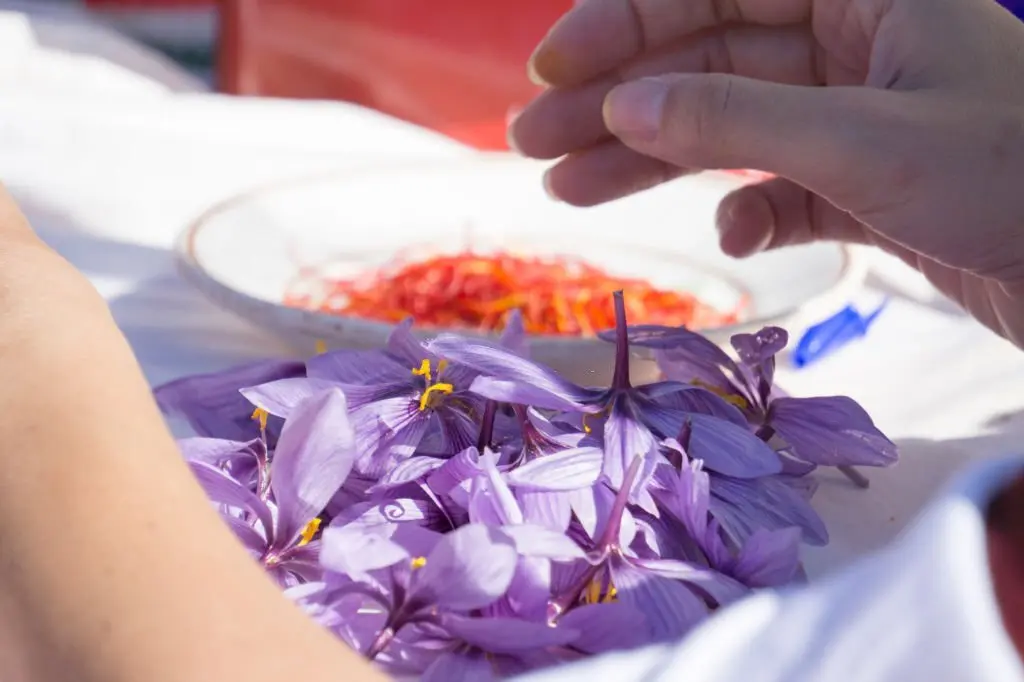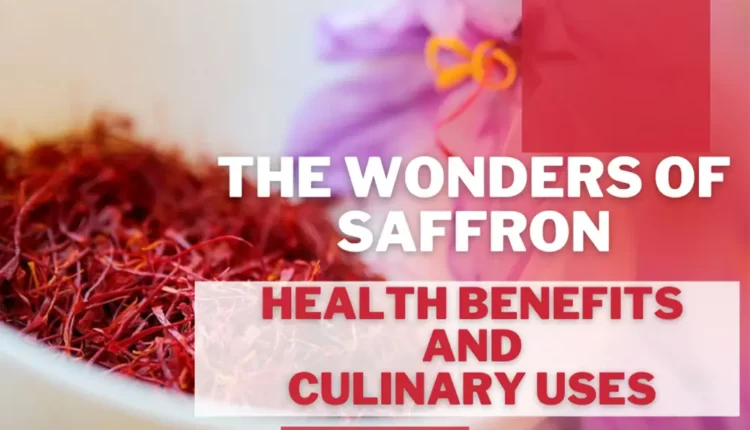In this article, we will explore all The Wonders of Saffron, from its chemical composition to its health benefits and culinary uses.
Saffron is one of the world’s most expensive spices, known for its unique flavor, aroma, and health benefits. It has been used in cooking, traditional medicine, and cosmetics for thousands of years. The spice comes from the dried stigma of the Crocus sativus flower, which blooms in the autumn.
Chemical Composition of Saffron
Saffron contains several chemical compounds that give it its characteristic color, flavor, and aroma. The most important of these compounds are crocin, picrocrocin, and safranal.
Crocin is a water-soluble carotenoid that gives saffron its distinctive red-orange color. It is also responsible for the spice’s bitterness and astringency.
Picrocrocin is a bitter-tasting compound that gives saffron its characteristic flavor. It is also responsible for the spice’s medicinal properties.
Safranal is a volatile compound that gives saffron its distinctive aroma. It is also responsible for the spice’s anti-inflammatory and anti-cancer properties.
Wonders of Saffron :

Health Benefits of Saffron
Saffron has been used for centuries in traditional medicine to treat a variety of ailments. Recent scientific studies have confirmed many of the spice’s health benefits. Here are some of the most important ones:
- Wonders of Saffron : Anti-inflammatory properties Saffron contains compounds that have anti-inflammatory properties. This makes it useful in treating conditions such as asthma, arthritis, and inflammatory bowel disease.
- Wonders of Saffron : Anti-cancer properties: Several studies have shown that saffron has anti-cancer properties. It can inhibit the growth of cancer cells and induce their death.
- Wonders of Saffron : Anti-depressant properties: Saffron has been shown to have anti-depressant properties. It can improve mood and reduce symptoms of depression.
- Wonders of Saffron : Memory enhancement: Saffron has been shown to enhance memory and cognitive function. It can also improve learning and retention.
- Wonders of Saffron : Cardiovascular health: Saffron has been shown to improve cardiovascular health. It can lower blood pressure, reduce cholesterol levels, and improve blood flow.

Culinary Uses of Saffron
Saffron is a highly prized spice in many cuisines around the world. It is used to add flavor, aroma, and color to a variety of dishes. Here are some of the most common culinary uses of saffron:
- Rice dishes: Saffron is commonly used in rice dishes such as biryani and paella. It adds a distinctive color and flavor to the rice.
- Soups and stews: Saffron is often used in soups and stews to add flavor and aroma. It is particularly popular in Middle Eastern and North African cuisines.
- Desserts: Saffron is used in a variety of desserts, including ice cream, custards, and cakes. It adds a unique flavor and aroma to these dishes.
- Beverages: Saffron is used to flavor a variety of beverages, including tea, coffee, and wine. It adds a distinctive aroma and taste to these drinks.
- Sauces and marinades: Saffron is often used in sauces and marinades to add flavor and color. It pairs well with seafood, chicken, and lamb.

How to Buy and Store Saffron
Saffron is a highly prized spice, and it is important to buy high-quality saffron to ensure that you get the best flavor and aroma. Here are some tips for buying and storing saffron:
- Look for high-quality saffron: Look for saffron that is dark red in color and has a strong aroma. Avoid saffron that is pale or has a weak aroma, as it may be of poor quality.
- Buy saffron in small quantities: Saffron is an expensive spice, so it is best to buy it in small quantities. This will ensure that you use it up before it loses its flavor and aroma.
- Store saffron properly: Saffron should be stored in an airtight container in a cool, dark place. This will help preserve its flavor and aroma. It is also important to keep saffron away from light, as exposure to light can cause it to lose its color and flavor.
- Use saffron sparingly: Saffron is a potent spice, so it should be used sparingly. A little goes a long way, so start with a small amount and add more if necessary.
- Check the expiration date: Saffron does have an expiration date, so it is important to check the date before using it. Expired saffron may have lost its flavor and aroma.
Check out our article on the What Is Saffron Used For In Cooking?
The Wonders of Saffron FAQs
Q: What is saffron and where does it come from?
A: Saffron is a spice that is derived from the dried stigmas of the Crocus sativus flower. It is commonly used in Middle Eastern, Indian, and Mediterranean cuisines.
Q: What gives saffron its unique properties?
A: Saffron contains several chemical compounds, including crocin, picrocrocin, and safranal, which give it its characteristic flavor, aroma, and color.
Q: What are the health benefits of saffron?
A: Saffron has been used in traditional medicine for centuries to treat a variety of ailments, and recent scientific studies have confirmed many of its health benefits. These include reducing inflammation, improving mood and cognition, and protecting against cancer.
Q: How should saffron be stored to preserve its properties?
A: Saffron should be stored in an airtight container in a cool, dark place away from light. This will help preserve its flavor, aroma, and color.
Q: How should saffron be used in cooking?
A: Saffron is a potent spice, so it should be used sparingly. It is often used to flavor and color rice dishes, soups, stews, and desserts. It can also be steeped in hot water to make saffron tea.
Q: What are some signs of high-quality saffron?
A: High-quality saffron should have a deep red color, a strong aroma, and a slightly bitter taste. It should also be relatively dry and free of any mold or other impurities.
Q: What are some common uses of saffron in traditional medicine?
A: Saffron has been used in traditional medicine to treat a variety of ailments, including depression, anxiety, menstrual cramps, and asthma. It has also been used as an aphrodisiac and to improve digestion.
Check out our article on the How To Use Saffron For Face Glow?
In conclusion,
saffron is a highly prized spice that is known for its unique flavor, aroma, and health benefits. It contains several chemical compounds that give it its characteristic properties, including crocin, picrocrocin, and safranal. Saffron has been used in traditional medicine for centuries to treat a variety of ailments, and recent scientific studies have confirmed many of its health benefits. Saffron is also a popular spice in many cuisines around the world, and it is used to add flavor, aroma, and color to a variety of dishes. When buying and storing saffron, it is important to look for high-quality saffron, store it properly, and use it sparingly. Wonders of Saffron
Thank you for taking the time to read this article on the properties of saffron. We hope that you found it informative and helpful in learning more about this valuable spice.
Whether you are a culinary enthusiast looking to experiment with new flavors in the kitchen, or someone interested in the health benefits of natural remedies, saffron is a fascinating and versatile ingredient that is worth exploring.
Remember to always source high-quality saffron and use it sparingly to fully enjoy its unique flavor and aroma.


